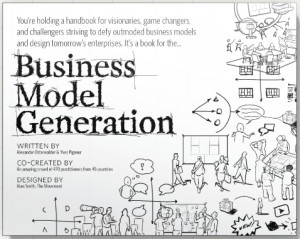<< Back to articles
Business model generation
7 December 2015 
 A MUST-READ HANDBOOK TO OPTIMIZE YOUR BUSINESS MODEL
A MUST-READ HANDBOOK TO OPTIMIZE YOUR BUSINESS MODEL
From the very first pages, I was seduced by this book’s avant-garde, minimalist style. It is a practical, inspiring work that explains the complexity of a business model in clear, concise terms. It teaches innovation techniques to understand, design and implement a new business model or analyze and optimize an existing one.
The book explains a business model through the relationships between the nine building blocks of a company, all in the form of a simple diagram, stripped down to the bare essentials. It shows how to get a global vision of your business, but above all how to optimize it in light of the changing economic context, evolving customer needs and profiles, varying availability of resources, etc.
The Nine Building Blocks of a Business Model
- Customer segments: For whom are we creating value? Whom should we serve in the future? What will the future customer look like? Who are our most important customers?
- Value propositions: What value do we deliver to our customers? What are they willing to pay for? Which of their problems are we helping to solve for them? Another book, equally interesting and relevant, was specifically written to help define the value propositions to customers: Value Proposition Design.
- Channels: Do our current distribution channels work well? Do they support the needs of our company and of our customers? Which distribution channels would work best to meet the needs of the future customer? Which ones are most cost-efficient?
- Customer relationships: What type of relationship does our customer expect? How can we actually “connect” with the customer? Is the preferred customer relationship understood and integrated across the company?
- Revenue streams: For what are our customers willing to pay and how much? How are they currently paying for products and services? What will change in the future? How much does each revenue source contribute to overall revenues?
- Key resources: What key financial, physical, intellectual and, of course, human resources are required to deliver our value propositions, desired customer relationships, distribution channels, etc.?
- Key activities: Which are the most important actions a company must take to deliver on customer needs and expectations, i.e. efficiency of production, problem solving, network/platform, financial analysis, etc.?
- Key partnerships: Who are our key partners that we cannot do without? Do they have too much power or is it a win-win relationship? Are they the right partners for what we want to accomplish?
- Cost structure: What are the most important costs incurred in our business model? What are our cost optimization opportunities? Are we at risk regarding cost trends of certain resources?
Simple? Obvious? Indeed, that might very well be your first reaction after reading this book that gives such a clear, straightforward explanation of a business model. Yet many leaders are still getting tangled up in intricate business plans for their projects. Mapping out your business model is a great way to structure your understanding, to optimize each element and to help you evaluate the efficiency and profitability of your investments (Return on Investment).
“Business Model Generation” written by Alexander Osterwalder & Yves Pigneur
Sylvie Grégoire, MBA, CRHA
President, Totem Performance organisationnelle
© Totem 2025, Tous droits réservés

 A MUST-READ HANDBOOK TO OPTIMIZE YOUR BUSINESS MODEL
A MUST-READ HANDBOOK TO OPTIMIZE YOUR BUSINESS MODEL